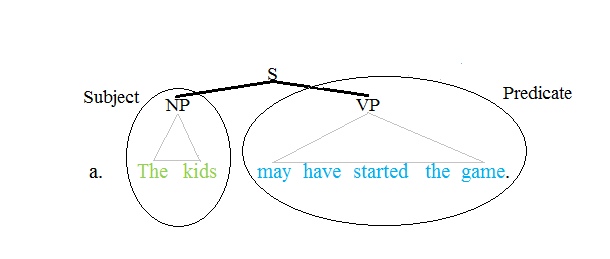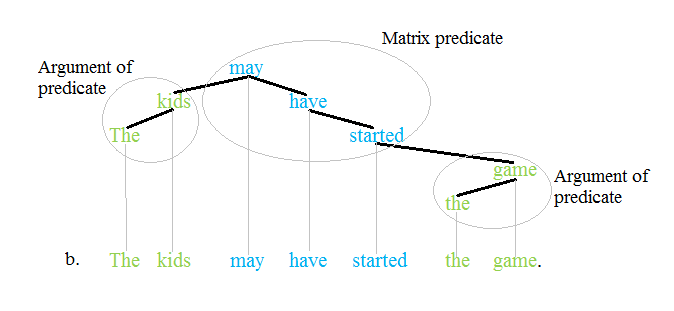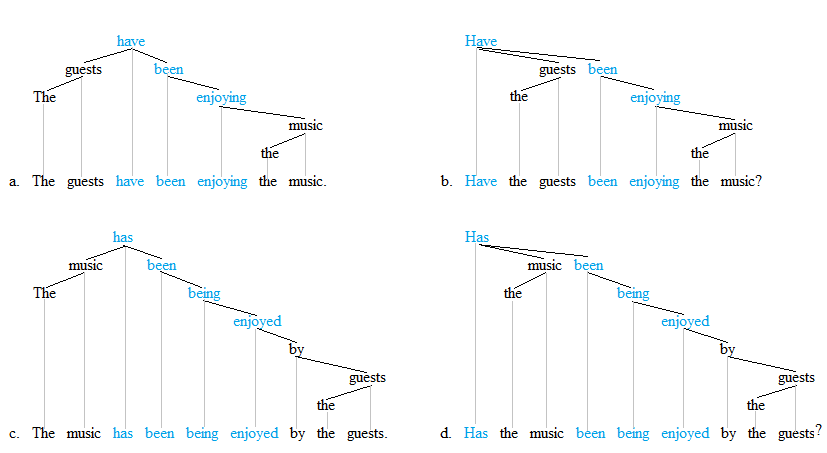Predicate (grammar)
There are two competing notions of the predicate in grammar.[lower-alpha 1] The first concerns traditional grammar, which tends to view a predicate as one of two main parts of a sentence, the other part being the subject. In the sentence Bill heard Fred, the predicate is heard Fred. On this approach, the purpose of the predicate is to complete an idea about the subject, such as what it does or what it is like. The second notion is derived from work in predicate calculus and first order logic and is prominent in modern theories of syntax and grammar. The predicate of a sentence corresponds to the main verb (and potentially to any auxiliary verbs that accompany the main verb); whereas the arguments of that predicate (e.g. the subject and object noun phrases) are outside the predicate. On this approach, the predicate in the sentence Bill heard Fred is just the verb heard. The competition between these two notions has generated confusion concerning the use of the term predicate in general. This article considers both of these notions.
| Grammatical features |
|---|
| Related to nouns |
| Related to verbs |
| General features |
| Syntax relationships |
|
| Semantics |
| Phenomena |
In traditional grammar
The predicate in traditional grammar is inspired by propositional logic of antiquity (as opposed to the more modern predicate logic).[lower-alpha 2] A predicate is seen as a property that a subject has or is characterized by. A predicate is therefore an expression that can be true of something.[1] Thus, the expression "is moving" is true of anything that is moving. This classical understanding of predicates was adopted more or less directly into Latin and Greek grammars; and from there, it made its way into English grammars, where it is applied directly to the analysis of sentence structure. It is also the understanding of predicates as defined in English-language dictionaries. The predicate is one of the two main parts of a sentence (the other being the subject, which the predicate modifies).[lower-alpha 3] The predicate must contain a verb, and the verb requires or permits other elements to complete the predicate, or it precludes them from doing so. These elements are objects (direct, indirect, prepositional), predicatives, and adjuncts:
- She dances. – verb-only predicate
- Ben reads the book. – verb-plus-direct-object predicate
- Ben's mother, Felicity, gave me a present. – verb-plus-indirect-object-plus-direct-object predicate
- She listened to the radio. – verb-plus-prepositional-object predicate
- They elected her president. – verb-plus-object-plus-predicative-noun predicate
- She met him in the park. – verb-plus-object-plus-adjunct predicate
- She is in the park. – verb-plus-predicative-prepositional-phrase predicate
The predicate provides information about the subject, such as what the subject is, what the subject is doing, or what the subject is like. The relation between a subject and its predicate is sometimes called a nexus. A predicative nominal is a noun phrase, such as in a sentence "George III is the king of England", the phrase "the king of England" being the predicative nominal. The subject and predicative nominal must be connected by a linking verb, also called a copula. A predicative adjective is an adjective, such as in Ivano is attractive, attractive being the predicative adjective. The subject and predicative adjective must also be connected by a copula.
This traditional understanding of predicates has a concrete reflex in many phrase structure theories of syntax. These theories divide an English declarative sentence (S) into a noun phrase (NP) and verb phrase (VP), e.g.[2]
The subject NP is shown in green, and the predicate VP in blue. This concept of sentence structure stands in stark contrast to dependency structure theories of grammar, which place the finite verb (= conjugated verb) as the root of all sentence structure and thus reject this binary NP-VP division, even for English. Languages with more flexible word order (often called nonconfigurational languages) are often treated differently also in phrase structure approaches.
In modern theories of syntax and grammar
Most modern theories of syntax and grammar take their inspiration for the theory of predicates from predicate calculus as associated with Gottlob Frege.[lower-alpha 4] This understanding sees predicates as relations or functions over arguments. The predicate serves either to assign a property to a singular term argument or to relate two or more arguments to each other. Sentences consist of predicates and their arguments (and adjuncts) and are thus predicate-argument structures, whereby a given predicate is seen as linking its arguments into a greater structure.[3] This understanding of predicates sometimes renders a predicate and its arguments in the following manner:
- Bob laughed. → laughed (Bob), or laughed = ƒ(Bob)
- Sam helped you. → helped (Sam, you)
- Jim gave Jill his dog. → gave (Jim, Jill, his dog)
Predicates are placed on the left outside of brackets, whereas the predicate's arguments are placed inside the brackets.[4] One acknowledges the valency of predicates, whereby a given predicate can be avalent (not shown), monovalent (laughed in the first sentence), divalent (helped in the second sentence), or trivalent (gave in the third sentence). These types of representations are analogous to formal semantic analyses, where one is concerned with the proper account of scope facts of logical quantifiers and logical operators. Concerning basic sentence structure, however, these representations suggest above all that verbs are predicates, and the noun phrases that they appear with their arguments. On this understanding of the sentence, the binary division of the clause into a subject NP and a predicate VP is hardly possible. Instead, the verb is the predicate, and the noun phrases are its arguments.
Other function words – e.g. auxiliary verbs, certain prepositions, phrasal particles, etc. – are viewed as part of the predicate.[5] The matrix predicates are in bold in the following examples:
- Bill will have laughed.
- Will Bill have laughed?
- That is funny.
- Has that been funny?
- They had been satisfied.
- Had they been satisfied, ...
- The butter is in the drawer.
- Fred took a picture of Sue.
- Susan is pulling your leg.
- Whom did Jim give his dog to?
- You should give it up.
Note that not just verbs can be part of the matrix predicate, but also adjectives, nouns, prepositions, etc.[6] The understanding of predicates suggested by these examples sees the main predicate of a clause consisting of at least one verb and a variety of other possible words. The words of the predicate need not form a string nor a constituent,[7] but they can be interrupted by their arguments (or adjuncts). The approach to predicates illustrated with these sentences is widespread in Europe, particularly in Germany.
This modern understanding of predicates is compatible with the dependency grammar approach to sentence structure, which places the finite verb as the root of all structure, e.g.[8]
The matrix predicate is (again) marked in blue and its two arguments are in green. While the predicate cannot be construed as a constituent in the formal sense, it is a catena. Barring a discontinuity, predicates and their arguments are always catenae in dependency structures.
Predicators
Some theories of grammar seek to avoid the confusion generated by the competition between the two predicate notions by acknowledging predicators.[9] The term predicate is employed in the traditional sense of the binary division of the clause, whereas the term predicator is used to denote the more modern understanding of matrix predicates. On this approach, the periphrastic verb catenae briefly illustrated in the previous section are predicators. Further illustrations are provided next:
The predicators are in blue. These verb catenae generally contain a main verb and potentially one or more auxiliary verbs. The auxiliary verbs help express functional meaning of aspect and voice. Since the auxiliary verbs contribute functional information only, they do not qualify as separate predicators, but rather each time they form the matrix predicator with the main verb.
Carlson classes
The seminal work of Greg Carlson distinguishes between types of predicates.[10] Based on Carlson's work, predicates have been divided into the following sub-classes, which roughly pertain to how a predicate relates to its subject.
Stage-level predicates
A stage-level predicate is true of a temporal stage of its subject. For example, if John is "hungry", then he typically will eat some food. His state of being hungry therefore lasts a certain amount of time, and not his entire lifespan. Stage-level predicates can occur in a wide range of grammatical constructions and are probably the most versatile kind of predicate.
Individual-level predicates
An individual-level predicate is true throughout the existence of an individual. For example, if John is "smart", this is a property that he has, regardless of which particular point in time we consider. Individual-level predicates are more restricted than stage-level ones. Individual-level predicates cannot occur in presentational "there" sentences (a star in front of a sentence indicates that it is odd or ill-formed):
- There are police available. - available is stage-level predicate
- *There are firemen altruistic. - altruistic is an individual-level predicate
Stage-level predicates allow modification by manner adverbs and other adverbial modifiers. Individual-level predicates do not, e.g.
- Tyrone spoke French loudly in the corridor. - speak French can be interpreted as a stage-level predicate
- *Tyrone knew French silently in the corridor. - know French cannot be interpreted as a stage-level predicate
When an individual-level predicate occurs in past tense, it gives rise to what is called a lifetime effect: The subject must be assumed to be dead or otherwise out of existence.
- John was available. - Stage-level predicate does NOT evoke the lifetime effect.
- John was altruistic. - Individual-level predicate does evoke the lifetime effect.
Kind-level predicates
A kind-level predicate is true of a kind of thing, but cannot be applied to individual members of the kind. An example of this is the predicate are widespread. One cannot meaningfully say of a particular individual John that he is widespread. One may only say this of kinds, as in
- Cats are widespread.
Certain types of noun phrases cannot be the subject of a kind-level predicate. We have just seen that a proper name cannot be. Singular indefinite noun phrases are also banned from this environment:
- *A cat is widespread. - Compare: Nightmares are widespread.
Collective vs. distributive predicates
Predicates may also be collective or distributive. Collective predicates require their subjects to be somehow plural, while distributive ones do not. An example of a collective predicate is "formed a line". This predicate can only stand in a nexus with a plural subject:
- The students formed a line. – Collective predicate appears with plural subject.
- *The student formed a line. – Collective predicate cannot appear with singular subject.
Other examples of collective predicates include meet in the woods, surround the house, gather in the hallway and carry the piano together. Note that the last one (carry the piano together) can be made non-collective by removing the word together. Quantifiers differ with respect to whether or not they can be the subject of a collective predicate. For example, quantifiers formed with all the can, while ones formed with every or each cannot.
- All the students formed a line. – Collective predicate possible with all the.
- All the students gathered in the hallway. – Collective predicate possible with all the.
- All the students carried a piano together. – Collective predicate possible with all the.
- *Every student formed a line. – Collective predicate impossible with every.
- *Each student gathered in the hallway. – Collective predicate impossible with each.
See also
- Clause
- Categorical proposition
- Dependency grammar
- Inflectional phrase
- Meaning-text theory
- Phrase
- Phrase structure grammar
- Predicative (adjectival or nominal)
- Secondary predicate
- Topic–comment
- Verb
Notes
- See for instance Oxford Concise Dictionary of Linguistics (1997, pp. 291).
- Concerning Aristotelian logic as the source for the binary subject-predicate division of the sentence, see Matthews (1981, p. 102).
- See for instance College Dictionary (1993, p. 1077) and Merriam Webster (2004, p. 566).
- There are exceptions to this statement. For instance, Matthews (1981, p. 85), Burton-Roberts (1986, pp. 28+), Thomas (1993, p. 15) and van Riemsdijk & Williams (1986, p. 326) continue to pursue the traditional stance whereby 'predicate' corresponds to the finite VP constituent.
References
- Kroeger 2005, p. 53.
- Constituency trees like the one here, which divides the sentence into a subject NP and a predicate VP, can be found in most textbooks on syntax and grammar, e.g. Carnie (2007), although the trees of these textbooks will vary in important details.
- For examples of theories that pursue this understanding of predicates, see Langendoen (1970, p. 96+), Cattell (1984), Harrocks (1987, p. 49), McCawley (1988, p. 187), Napoli (1989), Cowper (1992, p. 54), Haegeman (1994, p. 43ff.), Ackerman & Webelhuth (1998, p. 39), Fromkin (2000, p. 117), Carnie (2007, p. 51).
- For examples of this use of notation, see Allerton (1979, p. 259), van Riemsdijk & Williams (1987, p. 241), Bennet (1995, p. 21f).
- See for example Parisi & Antinucci (1976, p. 17+), Brown & Miller (1992, p. 63), Napoli (1989, pp. 14), Napoli (1993, p. 98), Ackerman & Webelhuth (1998, p. 39+). While the analyses of these linguists vary, they agree insofar as various types of function words are grouped together as part of the predicate, which means complex predicates are very possible.
- For examples of theories that extend the predicate to other word classes (beyond verbs), see Cattell (1984), Parisi & Antinucci (1976, p. 34), Napoli (1989, p. 30f), Haegeman (1994, p. 44).
- That many predicates are not constituents is acknowledged by many, e.g. Cattell (1984, p. 50), Napoli (1989, p. 14f).
- Dependency trees like the one here can be found in, for instance, Osborne, Putnam & Groß (2012).
- For examples of grammars that employ the term predicator, see for instance Matthews (1981, p. 101), Huddleston (1988, p. 9), Downing & Locke (1992, p. 48), and Lockwood (2002, p. 4f)
- Carlson (1977a), Carlson (1977b).
Literature
- Allerton, D (1979). Essentials of grammatical theory. London: Routledge & Kegan Paul.CS1 maint: ref=harv (link)
- Ackerman, F.; Webelhuth, G. (1998). A theory of predicates. Stanford, CA: CSLI Publications.CS1 maint: ref=harv (link)
- Burton-Roberts, N (2016). Analysing sentences: An introduction to English grammar. London: Longman.CS1 maint: ref=harv (link)
- The American Heritage College Dictionary (third ed.). Boston: Houghton Mifflin Company. 1993.
- Bennet, P. (1995). A course in Generalized Phrase Structure Grammar. London: UCL Press Limited.CS1 maint: ref=harv (link)
- Brown, E.K.; Miller, J.E. (1991). Syntax: A linguistic introduction to sentence structure. London: Routledge.CS1 maint: ref=harv (link)
- Carlson, G. (1977). A unified analysis of the English bare plural (PDF). Linguistics and Philosophy 1. 3. pp. 413–58.
- Carlson, G. (1977). Reference to Kinds in English. New York: Garland.
- Also distributed by Indiana University Linguistics Club and GLSA UMass/Amherst.
- Carnie, A. (2007). Syntax: A generative introduction (2nd ed.). Malden, MA: Blackwell Publishing.CS1 maint: ref=harv (link)
- Cattell, R. (1984). Composite predicates in English. Syntax and Semantics 17. Sydney: Academic Press.CS1 maint: ref=harv (link)
- Chomsky, N. (1965). Aspects of the theory of syntax. Cambridge, MA: MIT Press.CS1 maint: ref=harv (link)
- Cowper, E. (1992). A concise introduction to syntactic theory: The government-binding approach. Chicago: The University of Chicago Press.CS1 maint: ref=harv (link)
- Culicover, P. (1997). Principles and Parameters: An introduction to syntactic theory. Oxford University Press.CS1 maint: ref=harv (link)
- Downing, A.; Locke, P. (1992). English grammar: A university course (second ed.). London: Routledge.CS1 maint: ref=harv (link)
- Fromkin, V (2013). Linguistics: An introduction to linguistic theory. Malden, MA: Blackwell.CS1 maint: ref=harv (link)
- Haegeman, L. (1994). Introduction to government and binding theory (2nd ed.). Oxford: Blackwell.CS1 maint: ref=harv (link)
- Harrocks, G. (1987). Generative Grammar. London: Longman.CS1 maint: ref=harv (link)
- Huddleston, R. (1988). English grammar: An outline. Cambridge: Cambridge University Press.CS1 maint: ref=harv (link)
- Kroeger, P. (2005). Analyzing Grammar: An Introduction. Cambridge: Cambridge University Press.CS1 maint: ref=harv (link)
- Langendoen, T. (1970). The study of syntax: The generative-transformational approach to the study of English. New York: Holt, Rinehart and Winston.CS1 maint: ref=harv (link)
- Lockwood, D. (2002). Syntactic analysis and description: A constructional approach. London: continuum.CS1 maint: ref=harv (link)
- Matthews, P. (1981). Syntax. Cambridge: Cambridge University Press.CS1 maint: ref=harv (link)
- McCawley, T. (1988). The syntactic phenomena of English. 1. Chicago: University of Chicago Press.CS1 maint: ref=harv (link)
- The Merriam Webster Dictionary. Springfield, MA: Merriam-Webster. 2004.
- Napoli, D. (1989). Predication theory: A case study for indexing theory. Cambridge: Cambridge University Press.CS1 maint: ref=harv (link)
- Napoli, D. (1993). Syntax: Theory and problems. New York: Oxford University Press.CS1 maint: ref=harv (link)
- Osborne, T.; Putnam, M.; Groß, T. (2012). "Catenae: Introducing a novel unit of syntactic analysis". Syntax. 15 (4): 354–396.CS1 maint: ref=harv (link)
- Oxford Concise dictionary of Linguistics. New York: Oxford University Press. 1997.
- Oxford Dictionary of English Grammar. New York: Oxford University Press. 2014.
- Parisi, D.; Antinucci, F. (1976). Essentials of grammar. Translated by Bates, E. New York: Academic Press.CS1 maint: ref=harv (link)
- van Riemsdijk, H.; Williams, E. (1986). Introduction to the theory of grammar. Cambridge, MA: The MIT Press.CS1 maint: ref=harv (link)
- Thomas, L. (1993). Beginning syntax. Oxford: Blackwell.CS1 maint: ref=harv (link)
External links



